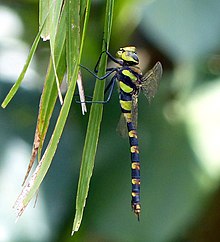Anax immaculifrons,[2] the magnificent emperor,[1] or blue darner,[3] is a species of dragonfly in the family Aeshnidae. Almost all its range is in West and South Asia (the population further east in Asia is now recognized as a separate species, A. aurantiacus); it is Europe's largest dragonfly but very marginal in the continent where restricted to some Aegean Islands and Cyprus.[4][5][6]
| Magnificent emperor | |
|---|---|

| |
| Male in Tamil Nadu, India | |

| |
| Female in Kerala, India | |
| Scientific classification | |
| Domain: | Eukaryota |
| Kingdom: | Animalia |
| Phylum: | Arthropoda |
| Class: | Insecta |
| Order: | Odonata |
| Infraorder: | Anisoptera |
| Family: | Aeshnidae |
| Genus: | Anax |
| Species: | A. immaculifrons
|
| Binomial name | |
| Anax immaculifrons Rambur, 1842
| |
Description
editA. immaculifrons has a length of 80–86 mm (3.1–3.4 in) and a wingspan of about 120 mm (4.7 in).[5][7] It is a large, bluish green dragonfly with sapphire-blue eyes, bluish-green thorax, and pale reddish-brown abdomen marked with black. Its thorax is pale bluish-green on dorsum with a blackish-brown mid-dorsal carina and turquoise-blue laterally. There is a narrow black stripe over humeral suture and a very broad one over the postero-lateral suture with a narrow black posterior border on metepimeron. Wings are transparent with amber-yellow tint. Segment 1 of the abdomen is entirely black. Segment 2 is turquoise-blue, with a mid-dorsal transverse mark shaped like a sea-gull in flight. Segment 3 has its basal half turquoise-blue and apical half black, with a small mid-dorsal spot on blue. Segments 4 to 8 are with apical half black and pale reddish-brown at base. Segment 9 and 10 are black on dorsum.[8] A more reddish form from southeast Asia and southern China was formerly included in this species, but in 2022 it was recognized as a separate species, A. aurantiacus.[6]
Behavior
editA. immaculifrons is found near slow flowing hill or mountain streams where it breeds. Eggs are inserted into reeds emerging from water.[8]
See also
edit- Emperor or blue emperor (Anax imperator), a relative that is widespread in Europe
- List of odonata species of India
- List of odonata of Kerala
References
edit- ^ a b Mitra, A. (2010). "Anax immaculifrons". IUCN Red List of Threatened Species. 2010: e.T165463A6022090. doi:10.2305/IUCN.UK.2010-4.RLTS.T165463A6022090.en. Retrieved 20 November 2021.
- ^ Paulson, D.; Schorr, M.; Abbott, J.; Bota-Sierra, C.; Deliry, C.; Dijkstra, K.-D.; Lozano, F. (2024). "World Odonata List". OdonataCentral, University of Alabama.
- ^ "Anax immaculifrons Rambur, 1842". indiabiodiversity.org. India Biodiversity Portal. Retrieved 2018-10-08.
- ^ "Anax immaculifrons Rambur, 1842 – Magnificent Emperor". Dragonflies and Damselflies - in and around Europe. Retrieved 25 November 2023.
- ^ a b "Indische Königslibelle – Anax immaculifrons" (in German). libellenwissen.de. Retrieved 25 November 2023.
- ^ a b Makbun, N.; Wongkamhaeng, K.; Keetapithchayakul, T.S. (2022). "Anax aurantiacus sp. nov., a new dragonfly from mainland Southeast Asia (Odonata: Aeshnidae)". Odonatologica. 51 (3–4): 301–339. doi:10.5281/odon.v51i3-4.a (inactive 1 November 2024).
{{cite journal}}: CS1 maint: DOI inactive as of November 2024 (link) - ^ "Magnificent emperor". Lepidoptera Libanotica. Retrieved 25 November 2023.
- ^ a b C FC Lt. Fraser (1936). The Fauna of British India, including Ceylon and Burma, Odonata Vol. III. Red Lion Court, Fleet Street, London: Taylor and Francis. pp. 145–146.
